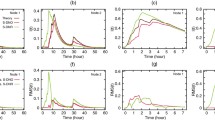Abstract
Understanding the effect of edge removal on the basic reproduction number \({\mathcal{R}_0}\) for disease spread on contact networks is important for disease management. The formula for the basic reproduction number \({\mathcal{R}_0}\) in random network SIR models of configuration type suggests that for degree distributions with large variance, a reduction of the average degree may actually increase \({\mathcal{R}_0}\). To understand this phenomenon, we develop a dynamical model for the evolution of the degree distribution under random edge removal, and show that truly random removal always reduces \({\mathcal{R}_0}\). The discrepancy implies that any increase in \({\mathcal{R}_0}\) must result from edge removal changing the network type, invalidating the use of the basic reproduction number formula for a random contact network. We further develop an epidemic model incorporating a contact network consisting of two groups of nodes with random intra- and inter-group connections, and derive its basic reproduction number. We then prove that random edge removal within either group, and between groups, always decreases the appropriately defined \({\mathcal{R}_0}\). Our models also allow an estimation of the number of edges that need to be removed in order to curtail an epidemic.
Similar content being viewed by others
References
Ball F, Neal P (2008) Network epidemic models with two levels of mixing. Math Biosci 212: 69–87
Bekessy A, Bekessy P, Komlos J (1972) Asymptotic enumeration of regular matrices. Stud Sci Math Hung 7: 343–353
Bender EA, Canfield ER (1978) The asymptotic number of labelled graphs with given degree sequences. J Comb Theory A 24: 296–307
Ellner SP, Guckenheimer J (2006) Dynamic models in biology. Princeton University Press, Princeton
Gillespie DT (1976) A general method for numerically simulating the stochastic time evolution of coupled chemical reactions. J Comput Phys 22: 403–434
Gillespie DT (1977) Exact stochastic simulation of coupled chemical reactions. J Phys Chem 81: 2340–2361
Kermack WO, McKendrick AG (1927) A contribution to the mathematical theory of epidemics. Proc Roy Soc Lond A 115: 700–721
Lindquist J, Ma J, van den Driessche P, Willeboordse FH (2009) Network evolution by different rewiring schemes. Physica D 238: 370–378
Lindquist J, Ma J, van den Driessche P, Willeboorsde FH (2010) Effective degree network disease models. J Math Biol 62: 143–164
May RM, Anderson RM, Irwin ME (1988) The transmission dynamics of human immunodeficiency virus (HIV). Phil Trans R Soc Lond B 321: 565–607
Miller JC (2011) A note on a paper by Erik Volz: SIR dynamics in random networks. J Math Biol 62: 349–358
Newman MEJ (2002) Spread of epidemic disease on networks. Phys Rev E 66: 016128
Newman MEJ, Strogatz SH, Watts DJ (2001) Random graphs with arbitrary degree distributions and their applications. Phys Rev E 64: 026118
Pastor-Satorras R, Vespignani A (2002) Epidemic dynamics in finite size scale-free networks. Phys Rev E 65: 035108(R)
van den Driessche P, Watmough J (2002) Reproduction numbers and sub-threshold endemic equilibria for compartmental models of disease transmission. Math Biosci 180: 29–48
Volz EM (2008) SIR dynamics in random networks with heterogeneous connectivity. J Math Biol 56: 293–310
Author information
Authors and Affiliations
Corresponding author
Rights and permissions
About this article
Cite this article
Koch, D., Illner, R. & Ma, J. Edge removal in random contact networks and the basic reproduction number. J. Math. Biol. 67, 217–238 (2013). https://doi.org/10.1007/s00285-012-0545-6
Received:
Revised:
Published:
Issue Date:
DOI: https://doi.org/10.1007/s00285-012-0545-6




